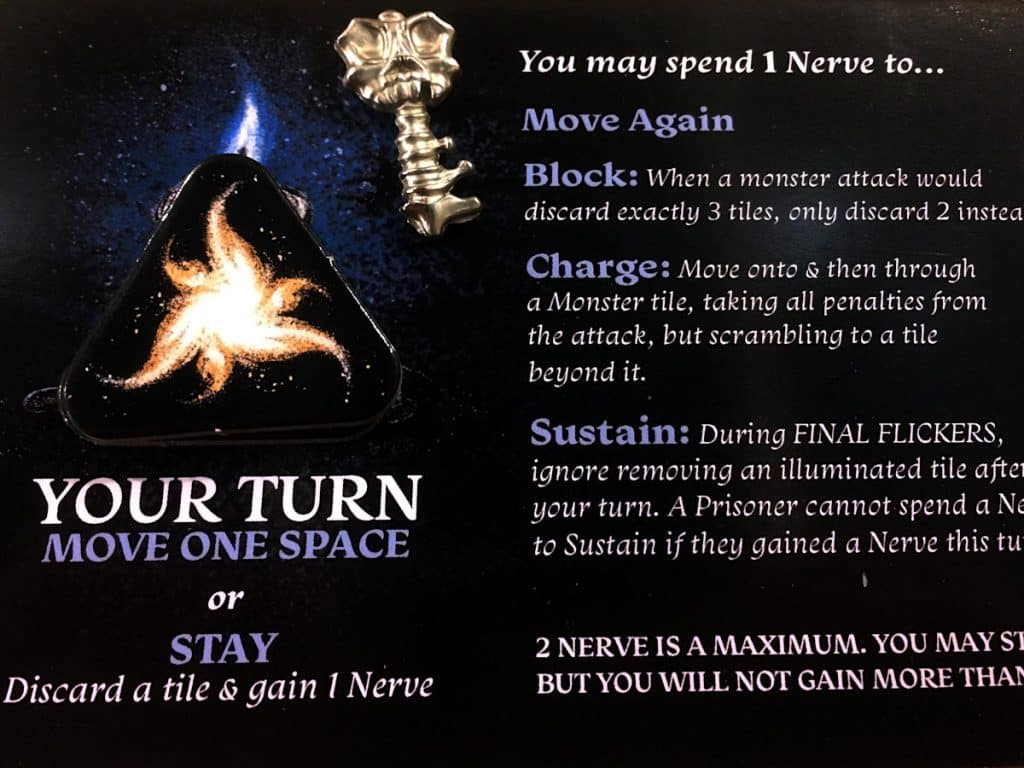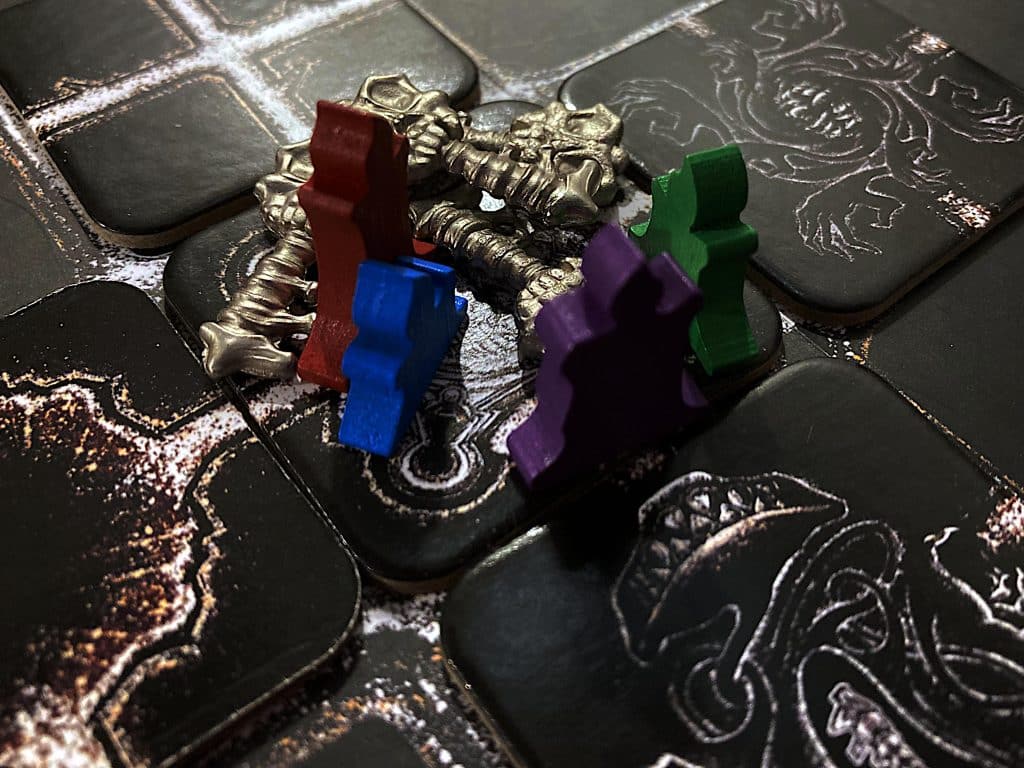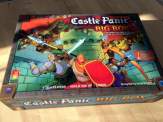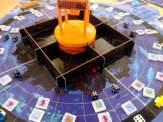| Release Date: 2021 | Players: 1-5 |
| Designer: Chris McMahon, Christopher Ryan Chan, Rosswell Saunders | Length: 45-60 minutes |
| Artist: Christopher Ryan Chan | Age: 12+ |
| Publisher: Smirk & Dagger Games | Complexity: 2.5 / 5 |
| Plastic (by weight): unknown | Air (by volume): unknown |
Your skin is cold as you awaken in the dark. You have nothing but a flickering candle. A terrifying foreboding is constricting your throat, just like the narrow passageway is squashing your body. You know you are trapped in the tightest, most claustrophobic tunnel labyrinth imaginable. Yet, you must find keys and gates that may vanish at any moment, your only path to freedom. You must press on and escape The Night Cage by Christopher Ryan Chan, Chris McMahon and Rosswell Saunders from Smirk & Dagger Games with art by Christopher Ryan Chan.
Listen to the Audio Version
Intro Music: Bomber (Sting) by Riot (https://www.
Music: Lost Place Atmospheres 003 by Sascha Ende
Link: https://ende.
Music: Cinematic Suspense Series Episode 002 by Sascha Ende
Link: https://ende.
Flickering Flames
The Night Cage is a cooperative, tile-laying survival game. Players begin on a black game board, divided into squares. You each have a candle illuminating only the tiles directly around you. You move from tile to tile to find a key, one for each player, and then meet at a gate and escape your prison. As you move, you reveal new tiles, but you also lose those tiles that you leave behind. So if you ever retrace your steps, you will find a different passageway. The result is an unstable, shifting, and treacherous labyrinth.
The tiles are drawn from a stack, similar to Carcassonne. The stack isn’t completely random, with the topmost tiles coming from a certain set to give you a head start. However, the rest of the tiles are shuffled at the beginning of the game. So you never know when you might find a key or a gate. Given that tiles that fall into darkness are removed from the game, there is a real chance that not everyone will get their key or that you lose the last gate. That means, at some point in the game, a player may be forced to stay still until the rest of the team can join them, just so they keep the light on the exit gate.
The problem is, standing still comes with a cost. You are forced to draw, reveal and then discard a tile from the stack. If you’re unlucky, you’ll discard a key or gate tile, making your way to freedom that bit more unlikely. On the other hand, staying in one place means you can soothe your nerves and gain a nerve token. These can be very helpful. However, their benefit doesn’t always outweigh the cost of losing a potentially important tile.

Monsters in the Shadows
There is one more thing though. Standing still could also mean that you discard a monster tile. Yes, The Night Cage houses creepy creatures, which you wouldn’t want to meet in broad daylight, let alone in a dark, narrow tunnel system. While every monster functions slightly differently, and you can add different ones depending on the difficulty level you want, all of them are bad news. So, standing still could mean that you avoid that.

Get yourself a wooden Tabletop Games Blog dice tray.
Each tray is the perfect size to roll your dice, and with the soft mat, it’s really quiet, while the wooden frame makes it wonderfully sturdy.
At this point, The Night Cage feels very like you’re Captain Dallas on the USCSS Nostromo crawling through the air vents in Alien. However, rather than brandishing a flamethrower, you hold the stump of a puny candle that threatens to go out at any moment. So, like in Alien, the terror in this game is not encountering a terrifying monster, but the threat of it being there, just out of reach of the cone of light that your flickering candle casts.
The art and components reinforce this oppressive mood. The tiles are small scribbles of white on deep, saturated black that threatens to swallow up every glimmer of hope. Player pieces are hunched silhouettes, more like prisoners than brave explorers. The skeleton keys that come with the game are solid and tactile, carrying a weight that feels almost too real, as if they truly are your salvation. Even the near-total blackness of the board surface traps you in the illusion of darkness.
It’s a sense of suffocation that runs through The Night Cage. You are never certain whether safety lies around the corner or whether something dreadful waits. Yet unlike in Alien, where anyone who dares to walk the ship alone is doomed, here the group work together. It’s this combination that makes the experience uniquely tense.
Ticking Timer
The Night Cage isn’t done with you yet, though. Like the time counting down to the end of the Alien film, the stack of tiles is this game’s relentless clock. Every time you draw from the pile, it pushes the group closer the end. While early turns lull you with a sense of calm, as the tiles start to run out, the pressure increases exponentially. The tile holder is shaped like a candle to remind you of the merciless passing of time. You can almost literally see the candle burning down. Every reveal tightens the grip of dread until the final few tiles, when escape is either at hand or forever lost.
What makes the countdown more unbearable is the risk of losing the last gate. You know how many gate tiles are in the game, and you can count them as you reveal or discard them. So if you get to the last gate tile, you need to keep it lit. If you can’t, you lose the game. One player must act as a guard, keeping their candle on the gate while others search for their key and return, so that you all can escape together. By the way, that’s unlike Alien, where Ripley is the only survivor. In The Night Cage, you all need to make it out as a team, or everyone loses.
Anyway, the unpredictability keeps every game unique. Keys may cluster early or remain hidden until the very end. Monsters may appear in quick succession or lurk unseen until the worst moment. No two plays are alike because the labyrinth is reshuffled with every game. That means you can’t rely on rehearsed strategies. You have to make sure you work as a well-oiled team. The darkness is never predictable, never safe, and never forgiving.

The Light at the End of the Labyrinth
The Night Cage is the kind of game that makes players lean forward in their seats, focused on the stack of tiles and the ever-shifting labyrinth. The way the game is designed, you are never distracted by a confusing number of options. There is only a tiny halo of light around your player piece, and at most, you have four directions to move in, plus the option to stay put. It is unlikely that anyone will end up overthinking their turns, even though nobody really wants to crawl into the darkness and face the known unknowns lurking in the shadows.
It’s a game that’s pretty easy to teach. The rules quickly become clear once you start to play. Within a few turns, everyone will understand how movement, lighting, and tile placement work. The rulebook can sometimes bury some details, but I suggest you just make a decision as a group and then look up the correct answer afterwards. You don’t want to break the flow of the game, or you risk bursting the tension.
Also, because nobody can see what’s up ahead, quarterbacking, where someone tells the rest of the group what to do, isn’t an issue in The Night Cage.
Once you have played the game a few times, you can choose from advanced monsters that make the nightmare more nightmarish. There are Keepers that patrol the tunnels like devious sentinels. The Pit Fiends corrupt the ground beneath you, turning tiles into hazards and effectively blocking safe routes.
So, overall, The Night Cage is a game that balances ease of teaching, replayability, and emotional impact, making it a rare cooperative game that keeps you crawling back into the dark time and again wanting more.
Keeping the blog running takes time and resources. So if you can chip in, that would be amazing.
Useful Links
- The Night Cage: https://www.
smirkanddagger. com/ product-page/ the-night-cage - Rulebook: https://drive.
google. com/ file/ d/ 1OfX0jC9aCqJSRzBWWKid2jwVHgzuh2hU/ view? usp= sharing - Rules video: https://www.
youtube. com/ live/ offbPlhznCw? si= 6FCEoTq-KfoB0_ Z8 - Smirk & Dagger Games: https://www.
smirkanddagger. com/ - BGG listing: https://boardgamegeek.
com/ boardgame/ 306709/ the-night-cage
Videos
Transparency Facts
- I played a friend's copy of the game.
- At the time of writing, I have not received financial support from the publisher or anyone working on their behalf.
Audio Version
Intro Music: Bomber (Sting) by Riot (https://www.
Music: Lost Place Atmospheres 003 by Sascha Ende
Link: https://ende.
Music: Cinematic Suspense Series Episode 002 by Sascha Ende
Link: https://ende.
Playlist
These are the songs I listened to while I was writing this review:





